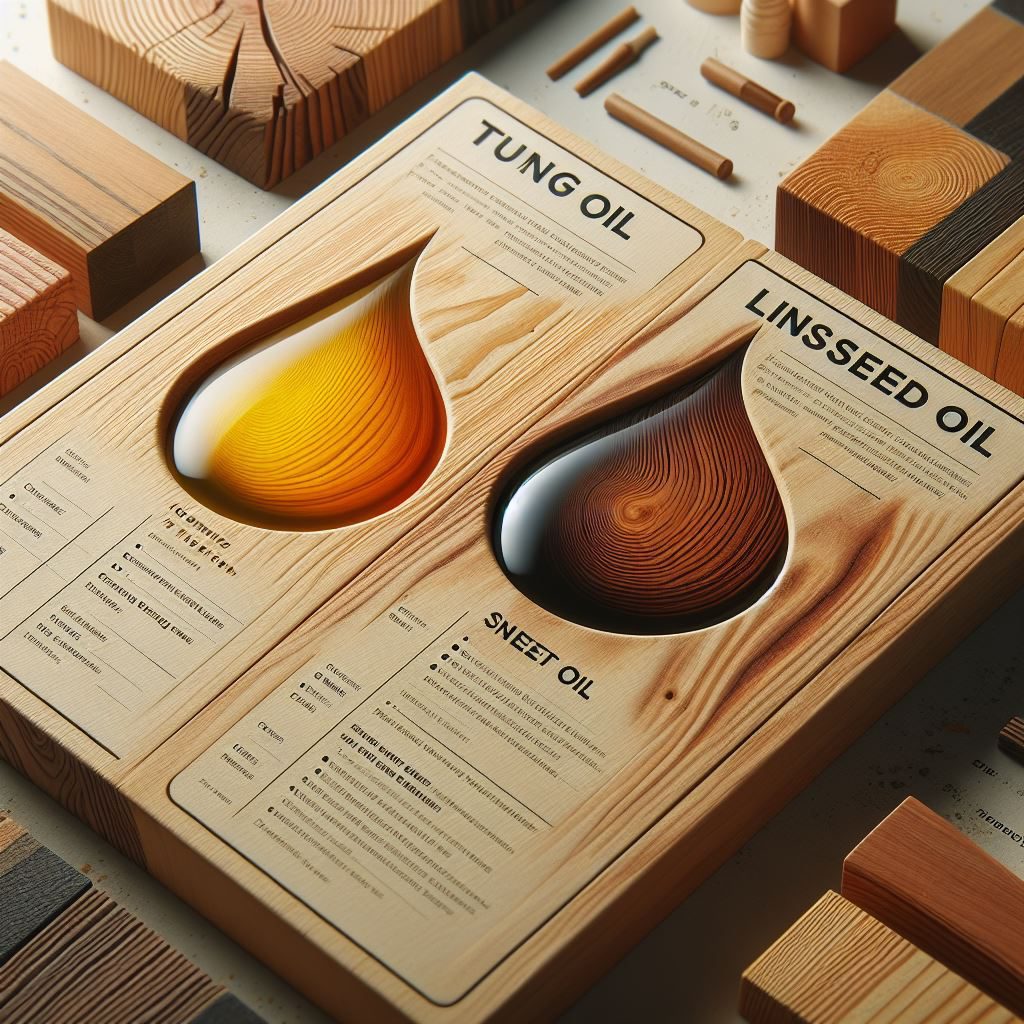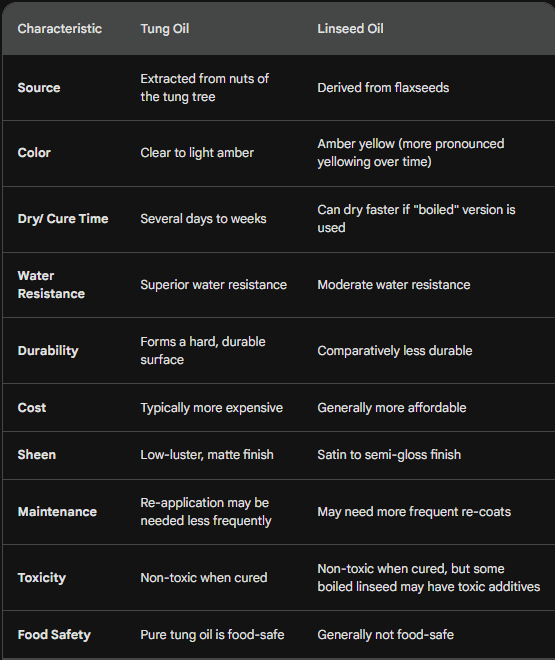
Tung Oil vs. Linseed Oil: Deciding on the best natural wood finish can be tricky. Both tung oil and linseed oil offer unique benefits, but their distinct properties make them ideal for different projects. Let’s explore their differences to help you make the right choice.
Wood brings undeniable warmth and charm to our homes. Whether you’re an experienced woodworker or a DIY enthusiast, applying a quality finish is key to enhancing the beauty and lifespan of your wooden creations. Tung oil and linseed oil are two time-tested, natural choices for wood finishing. Let’s explore their unique traits to see which is best suited for your projects.
Tung Oil vs. Linseed Oil: Major Differences
Let’s break down the key distinctions between tung oil and linseed oil

Factors to Consider When Choosing Between Tung Oil vs. Linseed Oil
- Appearance: Are you looking for a clear, natural finish or a slightly amber, warmer tone?
- Water Resistance: How resistant does your wood project need to be against moisture?
- Care and Cleaning: How often are you prepared to maintain the finish?
- Durability and Maintenance: Is your project meant for frequent use and likely to take wear and tear?
- Application: Tung oil usually requires multiple thin coats with greater cure time in between, while linseed oil might be less labor-intensive in some cases.
- Cost: Are you on a budget, or can you invest in a slightly pricier but longer-lasting finish?
- Lifespan: Tung oil may have a longer lifespan on high-use items, while linseed may work for decorative pieces used less.
- Best Uses: Each oil performs well in certain specific applications. Let’s dive into this.
When to Use Tung Oil vs. Linseed Oil
Ideal situations for Tung Oil
- Outdoor furniture and decks
- Wooden boats or marine applications
- Kitchen countertops and cutting boards (pure tung oil)
- Wooden tools and handles
- Projects requiring maximum protection from water
Ideal situations for Linseed Oil
- Indoor furniture
- Decorative or less-used wooden items
- Wooden bowls and utensils (with caution- food safe variations are needed)
- Projects desiring a warm, antique-like look
FAQ
-
Which is the best wood finish, tung oil or linseed oil?
There’s no universal answer. The “best” option depends entirely on your individual project’s needs.
-
What are the disadvantages of tung oil and linseed oil?
Tung oil’s potential downsides are greater expense and a longer drying time. Linseed oil may present lower durability and a stronger tendency to yellow with age.
-
Which oil is best for protecting wood?
It depends on the wood type and exposure. For harsh outdoor use, tung oil often wins.
-
Can you mix tung oil and linseed oil?
Yes, though be aware this mix will inherit features of both oils.
-
How do I prepare wood for tung oil or linseed oil?
Before applying either oil, sanding creates a critical foundation. Start with coarser grit sandpaper and gradually work to finer grits for a smooth surface. Thoroughly remove sawdust and any debris before applying the oil.
Is tung oil suitable for outdoor projects?
Yes! Tung oil’s superior water resistance makes it a superb choice for outdoor furniture, decks, and similar wood items. Ensure you apply enough coats and periodically refresh the finish for lasting protection.
Conclusion
Tung oil and linseed oil are both fantastic natural options for wood finishing. Understanding their properties is crucial in picking the most suitable solution for your project. You can select whether tung oil’s hardiness or linseed’s warmth best fulfills your needs by considering how and where your wood piece will be used. Here are some final tips:
- Read labels carefully: Ensure you get pure tung oil if food safety is a priority. For linseed oil, check if “boiled” (faster drying but sometimes contains toxic additives) or “raw” (slow cure, more likely to be truly food-safe).
- Always test first: Experiment on a scrap piece of wood before tackling your main project.
- Proper application is key: Research the best way to apply your chosen oil for ideal results. Thin coats win the race!
How to prepare wood for tung oil or linseed oil
- Sanding is imperative! Start with a rougher grit sandpaper and gradually progress to finer grits. This creates a smooth surface for the oil to adhere to.
- Remove dust and debris. Wipe down the wood thoroughly before application.
Can you apply tung oil over linseed oil or vice versa?
While generally not recommended, you can apply tung oil over cured linseed oil if the surface is prepared correctly. Conversely, linseed oil won’t adhere well over cured tung oil due to its greater water resistance.
How long does tung oil or linseed oil need to dry?
- Tung Oil: Individual coats could take days, potentially weeks for full cure, depending on humidity and number of coats.
- Linseed Oil: Boiled linseed oil dries faster, potentially within a day. Raw linseed may take significantly longer.
Is tung oil safe for exterior use?
Absolutely! Tung oil’s water resistance makes it excellent for outdoor projects. Ensure adequate coats and refresh finish as needed.

























